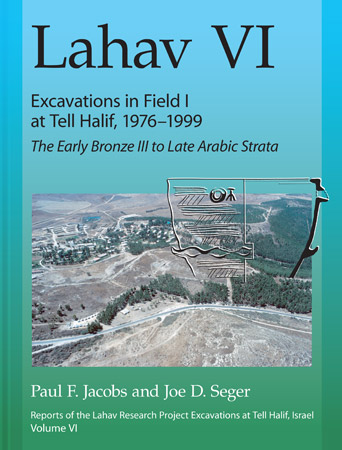
Lahav VI: Excavations in Field I at Tell Halif, 1976–1999
The Early Bronze III to Late Arabic Strata
Paul F. Jacobs and Joe D. Seger
Lahav VI: Excavations in Field I at Tell Halif, 1976–1999
The Early Bronze III to Late Arabic Strata
Paul F. Jacobs and Joe D. Seger
This is the sixth volume in the series of reports on investigations by the Lahav Research Project (LRP) at Tell Halif in Southern Israel. This work focuses on the Project’s efforts in Field I conducted during eight excavation seasons between 1976 and 1999. Field I was opened down the northeast slope of the tell in order to assess the long-term history of occupation at the mound site. Its excavation work documented the presence of fifteen primary occupation strata, including 46 sub-phases, stretching from the Early Bronze III period in the mid-third millennium B.C.E. to modern times. The major exposures include four strata of EB III remains (Strata XV to XII), and another five of LB to early Iron I materials (Strata XI to VII). Traces of Iron II (Stratum V)I and Persian (Stratum V) remains were found in one area at the crest of the mound, where levels were otherwise disturbed by a modern army trench and Bedouin graves (Stratum I). A few modest remains of Late Roman/Byzantine (Stratum III) and Islamic (Stratum II) eras were identified in downslope areas.
- Description
This is the sixth volume in the series of reports on investigations by the Lahav Research Project (LRP) at Tell Halif in Southern Israel. This work focuses on the Project’s efforts in Field I conducted during eight excavation seasons between 1976 and 1999. Field I was opened down the northeast slope of the tell in order to assess the long-term history of occupation at the mound site. Its excavation work documented the presence of fifteen primary occupation strata, including 46 sub-phases, stretching from the Early Bronze III period in the mid-third millennium B.C.E. to modern times. The major exposures include four strata of EB III remains (Strata XV to XII), and another five of LB to early Iron I materials (Strata XI to VII). Traces of Iron II (Stratum V)I and Persian (Stratum V) remains were found in one area at the crest of the mound, where levels were otherwise disturbed by a modern army trench and Bedouin graves (Stratum I). A few modest remains of Late Roman/Byzantine (Stratum III) and Islamic (Stratum II) eras were identified in downslope areas.
These excavations revealed that, following a robust occupation on the site’s Eastern Terrace in the EB I period, it lay fallow in EB II, settlement only to recover on the hillock to the west as a major fortified enclave in EB III. Then, after another gap in occupation during the EB IV and MB periods, it recovered again in the early LB I era, becoming an emporium associated with Egyptian trade, hence thriving, with continuity of occupation into the Iron Age and beyond.
Also of Interest
Mailing List
Subscribe to our mailing list and be notified about new titles, journals and catalogs.




